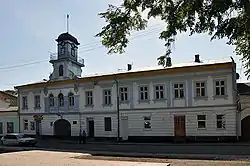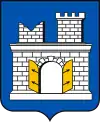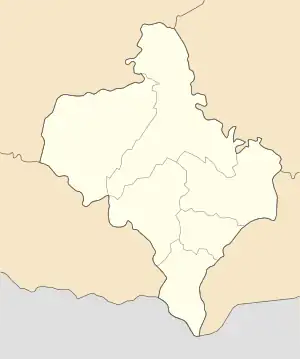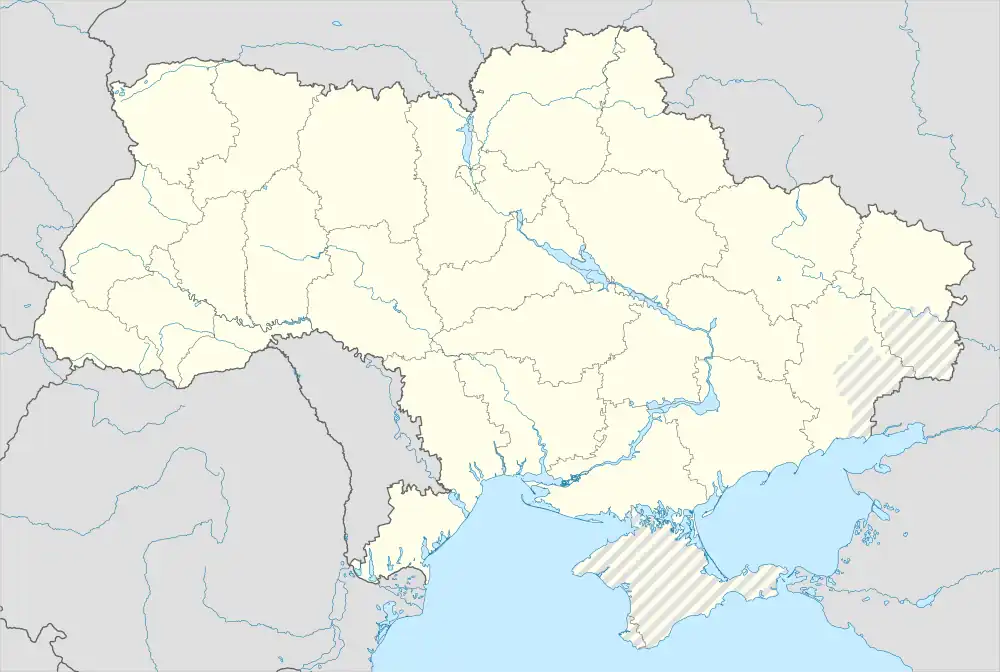Kuty
Кути Cuturi | |
|---|---|
 Kuty town hall | |
 Coat of arms | |
 Kuty Location of Kuty in Ukraine  Kuty Kuty (Ukraine) | |
| Coordinates: 48°15′26″N 25°10′2″E / 48.25722°N 25.16722°E | |
| Country | |
| Oblast | |
| Raion | Kosiv Raion |
| First mentioned | 1469 |
| City rights | 18th century |
| Government | |
| • mayor | Dmytro Pavliuk |
| Area | |
| • Total | 49 km2 (19 sq mi) |
| Population (2022) | |
| • Total | 4,001 |
| Time zone | EET |
Kuty (Ukrainian: Кути; German: Kutten; Polish: Kuty; Yiddish: קיטעוו, romanized: Kitev, Romanian: Cuturi), also known historically as Kitów,[1] is an urban-type settlement in Kosiv Raion, Ivano-Frankivsk Oblast, western Ukraine. It is situated on the Cheremosh River. It is one of the historical centres of the ancient region of Pokuttya, the name of which may derive from the township. The current population estimate is 4,001 (2022 estimate).[2] Kuty hosts the administration of Kuty settlement hromada, one of the hromadas of Ukraine, which consists of Kuty township and 6 villages.[3] Kuty is often associated with Kitów, Poland, as both settlements have historic familial connections, both communities suffered the destruction of their Jews during the Holocaust,[4] both are located in the historical region of Galicia, both are the originators of the Kitowski surname,[5] and the two towns share a placename in Polish.
History
Kuty, which means "angles" or "corners" in Ukrainian, was first mentioned in records of 1469 as a village in the estate of Jan Odrowąż, then Polish archbishop of Lwów (now Lviv) and personal adviser to several Polish kings.[6] Over time the settlement grew and in 1715 at the request of Jan Potocki, the voivod of Kiev, King Augustus II the Strong granted it a town charter. Two churches were founded for local Uniates and Armenians. With expansion and the proximity of Bukovina, the town became the seat of a starost in the region of Halych and an administrative centre within the Ruthenian Voivodship of the Polish–Lithuanian Commonwealth.
The town was the Fiefdom of the Potocki family until the partitions of Poland. In 1772 it came under Austrian administration and on May 1, 1782 Kuty lost its town privileges. As a result, its economic growth halted and Kuty remained a provincial backwater inhabited mostly by Jewish and Armenian merchants. Around 1850 the town was linked to the rest of Galicia by the Kołomyja-Czerniowce railway. However, as both Galicia and Bukovina were under Austrian rule, it could not capitalize on its status as a border town. From the 19th-century onwards, Kuty acquired fame as a holiday resort owing to its picturesque location, on a river surrounded by hills and blessed with a balmy climate. It was known as a fruit-growing area and associated festivals. It was home to the largest Armenian community in Poland, many of whom had settled there from Moldova.
After the collapse of the Central Powers in 1918 the town was briefly under the control of the West Ukrainian People's Republic. After seizure by Romania Kuty returned to newly independent Polish administration. It became the most important border crossings between Poland and Romania. In 1930 the Polish Army built a new wooden bridge across the Cheremosh river.
It was in Kuty that the Polish president, Ignacy Mościcki, spent his last days in Poland before crossing the border into exile during the 1939 Polish Defensive War against the Germans and the Soviets attacking on two fronts.[7][8] The town was defended by the Polish Army until September 20, 1939. Among the last soldiers to be killed by the Red Army in heavy fighting for the bridge was the notable Polish writer, Tadeusz Dołęga-Mostowicz. Except for the term of German occupation between 1941 and 1944, Kuty was annexed by the USSR in 1939 and was administered by Soviet Ukraine. In the spring of 1944, Ukrainian nationalists killed about 200 Poles and Armenians.
Since 1991 Kuty has been part of independent Ukraine.
Jewish community
In the spring of 1942, during the German occupation, the entire Jewish population of Kuty was killed by the Nazis. Many died in the town while the rest were rounded up and deported to the ghetto in Kolomyia. Only a handful survived. [9]
Demography
In 1849 the town had roughly 3,700 inhabitants, in 1880, 6,300 and in the late 1920s – 8,000. Of these 3,300 were Jews, 1,900 Hutsuls, 1,300 Poles and over 500 Armenians.[10] In 2001, the population was 4,272, and in 2016 ca. 4,085 (2016 est.)[11].
Notable residents
- Edmund Charaszkiewicz (1895-1975), Polish intelligence officer
- Eliasz Kuziemski (1922–2000), Polish actor
- Vira Vovk (1926-2022), Ukrainian writer
- Abraham Gershon of Kitov (1701-1761), rabbi
- Haim Drukman (1932-2022), rabbi and educator, Israeli politician
- Levko Dutkovskiy (born 1943), musician and composer, founder and leader of the vocal-instrumental ensemble "Smerichka" which included legendary artists Volodymyr Ivasyuk, Nazariy Yaremchuk and Vasyl Zinkevych. People's Artist of Ukraine, director, teacher, one of the founders of Ukrainian pop music.
References
- ↑ "Zablotow, Ukraine". www.jewishgen.org. Retrieved 2023-04-03.
- ↑ Чисельність наявного населення України на 1 січня 2022 [Number of Present Population of Ukraine, as of January 1, 2022] (PDF) (in Ukrainian and English). Kyiv: State Statistics Service of Ukraine. Archived (PDF) from the original on 4 July 2022.
- ↑ "Кутская громада" (in Russian). Портал об'єднаних громад України.
- ↑ "Martyrologia Wsi Polskich". 2015-02-15. Archived from the original on 2015-02-15. Retrieved 2023-04-03.
- ↑ "Kitowski Name Meaning & Kitowski Family History at Ancestry.com®". www.ancestry.com. Retrieved 2023-04-03.
- ↑ Feliks Kiryk. "Jan Odrowąż, h. Odrowąż" (in Polish). iPSB. Retrieved 15 March 2019.
- ↑ Count Edward Raczynski In Allied London Weidenfeld and Nicolson 1962 Page 39
- ↑ Editor Waclaw Jedrzejewicz Poland in the British Parliament 1939-1945 Volume I Jozef Pilsudski 1946 Page 317
- ↑ The Kitov Yizkor Book, Eisig Husen, New York 1958
- ↑ Mikołaj Falkowski. "Kuty, na końcu Polski". historia.polskieradio.pl (in Polish). Polish Radio. Retrieved 2009-08-22.
- ↑ "Чисельність наявного населення України (Actual population of Ukraine)" (PDF) (in Ukrainian). State Statistics Service of Ukraine. Retrieved 19 July 2016.
Further reading
External links
 Media related to Kuty, Kosiv Raion at Wikimedia Commons
Media related to Kuty, Kosiv Raion at Wikimedia Commons